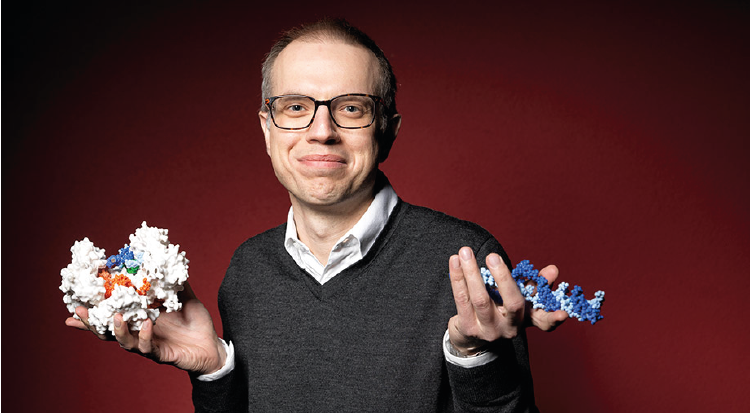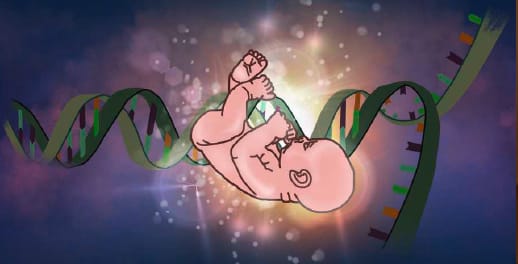Text: Stefan Stöcklin, Translation: Michael Craig
Martin Jinek, biochemist, is a polite, reserved character. But when the conversation turns to He Jiankui, he voices his opinion loud and clear: “He did irresponsible experiments that are harmful to children and science.” By manipulating early embryos, the Chinese researcher last year became the first person to irrevocably alter human genetic material. And he used genetic scissors called CRISPR/Cas9, co-developed by Martin Jinek, to do it. CRISPR/Cas9 enables genetic material to be modified easily, quickly and precisely, which is why the technology has very rapidly gained acceptance among scientists.
He Jiankui’s intervention breaks a taboo. Jinek followed the Hong Kong conference where – in a calm voice and with visible pride – the misguided Chinese researcher explained his experiments to the scientific community. “I listened with a mixture of disapproval and disbelief,” Jinek remembers, still angered by the scientist’s irresponsibility and temerity. While there has still been no independent verification even months after the announcement, few doubt that He, who has since gone to ground, actually did the experiments as claimed.
Breakthrough in California
Martin Jinek’s office on Irchel Campus is absolutely spick and span, with its few books arranged in neat rows. In a corner stand a bass guitar and amplifier, one of the few distractions the scientist allows himself. Otherwise the room is austere and reduced to the essentials – a space for new ideas and exciting experiments. Jinek’s reputation as a researcher is closely bound up with the CRISPR/Cas9 genetic editing method. While his name isn’t the first mentioned when talk turns to the revolutionary method – Jennifer Doudna, Emmanuelle Charpentier and Feng Zhang are acknowledged as its inventors – as a postdoc in Doudna’s California lab Jinek did crucial experiments, publishing them in the journal Science in 2012. The publication paved the way for broad application of the method, which is now used all over the world to manipulate human, animal, plant and bacterial cells, primarily for research purposes, but also for treating genetic diseases.
This work has fueled Jinek’s scientific career: He’s received multiple awards, was made associate professor at the Department of Biochemistry at age 39, has a worldwide network, leads a group of 14 people, and is a sought-after expert for specialist committees and media. It’s no wonder he’s “extremely satisfied with the way things have gone.” The fact that his former boss Doudna and other people have gotten more of the limelight doesn’t bother him: “That’s how science works.” Added to that, the decisive experts in the field all know very well how crucial his contribution really was.
Martin Jinek wasn’t handed a scientific career on a plate. He comes from a provincial town in the north-east of what is now the Czech Republic. While he was interested in scientific subjects at school, he was also interested in languages, especially English. That was unusual in mid-1980s Czechoslovakia. He owes this fascination to his father, who was more oriented to the West than to the East in political terms, and encouraged his son to learn English. Thanks to these language skills, 17-year-old Jinek was able to successfully apply for a scholarship to a boarding school in Reading, UK. This was the gifted student’s springboard to the renowned Trinity College Cambridge, where he studied chemistry and natural sciences.
“What interests me is the chemistry of living cells, or to be more precise the molecular mechanisms of biomolecules,” explains Jinek in flawless English. If you imagine the major molecules of a cell as a kind of machine which can perform certain tasks thanks to its atomic structure, a knowledge of their spatial structures gives an insight into how they function. Particularly revealing are the structural changes that take place when different molecules interact: For example when the genetic molecules DNA and RNA interact with proteins, because genetic information is activated or deactivated in the process. “Only through a knowledge of structures can we understand the processes in cells,” explains Jinek.
In his first research work as a student in Kyoshi Nagai’s lab in Cambridge, Martin Jinek was already looking at the structures of biomolecules and their functions: “Nagai kindled this passion in me.” Later on, during his thesis in Elena Conti’s lab in Heidelberg, he studied the activities of enzymatic proteins. After that his focus shifted to the nucleic acid RNA because, as he explains, he found the single-stranded molecule more interesting biologically than the double-stranded DNA. In Jennifer Doudna’s lab he first worked on another project, without success, before becoming aware of the topic of CRISPR. Jinek took a close look at the system from a structural biology point of view, bringing off his great coup in 2012. Immediately after this scientific highpoint he came to the UZH Department of Biochemistry as an assistant professor. Since then he’s been progressively setting up his own group, as well as publishing with great frequency. “The interactions between RNA and proteins, which are also important for CRISPR, are still my pet topic,” says Jinek.
The scientist, who lives in Basel and commutes to Zurich, appears to be well organized, and weighs up his answers carefully. In terms of both temperament and outward appearance, Jinek is the diametric opposite of an absent-minded, chaotic professor. It’s not just his office that’s tidy: The labs are also extremely neat. It comes as no surprise that Jinek and his team regularly have clean-up days. When asked what makes good science, he refers to his teachers: “From them I learned to ask the right questions, and then address these questions with the right experiments.” He’s taken this motto to heart and has tried to pass it on to his own staff – evidently with success, as he has a reputation for being a good mentor.
You could say that He Jiankui asked the wrong questions, as the CRISPR/Cas9 system isn’t yet reliable enough to rule out undesired genetic effects. “The interventions aren’t just dangerous for the children; they’re also unnecessary from a medical point of view,” says Jinek. The protection from HIV He was trying to achieve would in this case also have been possible by other means. What’s more problematic is the violation of the ethical taboo, because the gene manipulation will be passed on to any children the subjects might have in the future. Germline gene therapy is banned in most countries, including Switzerland. “We should keep it that way, “ says Jinek.
He does not feel responsible for his fellow scientist’s transgression of the limits. “Scientific knowledge can always be misused,” he says, pointing to the useful medical applications made possible thanks to the gene editing scissors. Alongside his basic research, Jinek is also working with various colleagues to optimize the CRISPR system to cure specific types of cancer and genetic conditions. In these cases the planned interventions only target somatic cells and therefore will not affect succeeding generations. Martin Jinek is convinced that “CRISPR/Cas-9 will bring medical progress.” For him it’s clear that the gene scissors will prove their worth, despite the actions of renegade He Jiankui.
Where are you at your most creative?
At the office or in the kitchen.
What do you do to clear your mind and think of new things?
Ideally playing music, jogging or reading.
Which famous person would you like to dine with and why?
Dave Gilmour, the Pink Floyd guitarist and songwriter. I play a bit of guitar myself, and I like his style of music.
Three books that you would take with you to a desert island?
1984by George Orwell, TheLittle Princeby Antoine de Saint-Exupéry and The Spy Who Came in from the Coldby John le Carré.
Ballpoint or laptop?
Neither. I prefer a fountain pen.
The mountains or the beach?
The mountains, or even better the rainforest.



